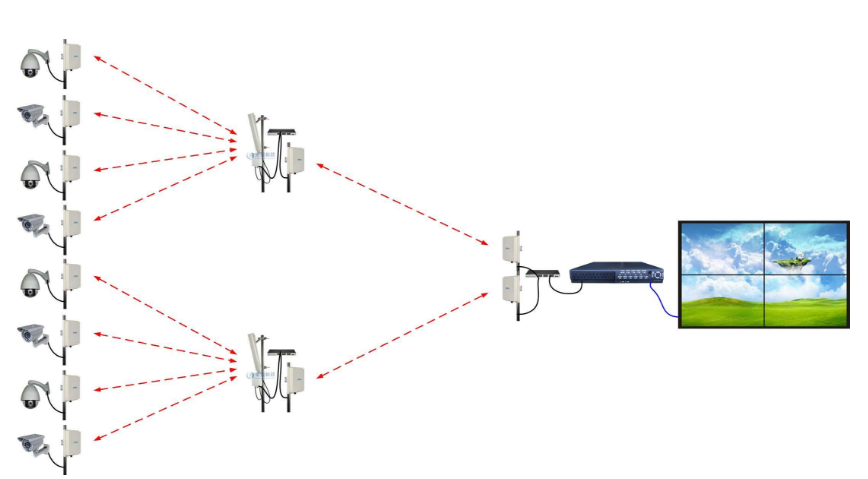With the continuous development of technology, the continuous advancement of wireless technology has promoted the wide application of long-distance wireless video surveillance. Among them, the application of wireless bridges is more common. What is a wireless bridge? As the name suggests, wireless bridges are the bridges of wireless networks. They use wireless transmission to bridge the communication between two or more networks. Wireless bridges are divided into circuit-type bridges and data-type bridges from the communication mechanism. Let's take a closer look at the wireless bridge knowledge.
First, the application scenario of the wireless bridge:
Wireless bridges are mainly used in some areas where wiring is not possible, such as: railway, oil, mining, water conservancy, community, forest fire prevention, road monitoring, building a safe city, building wireless monitoring inside the elevator, wireless transmission, wireless audio control, etc. The most widely used is wireless video transmission.

Second, the wireless network bridge application?
Point-to-point networking: Point-to-point type is “direct transmissionâ€. Wireless bridge devices can be used to connect two fixed networks in different buildings.
Relay networking mode: “indirect transmissionâ€. When there is a barrier between the A access point and the B access point that directly affects the transmission, the relay mode can be adopted, and the relay point is set at the obstacle, so that the signal can be transmitted from the A access point to the B access point. the goal of.

Point-to-multipoint wireless networking: A point-to-multipoint wireless bridge can connect multiple discrete remote networks into one, and the structure is more complicated than a point-to-point wireless bridge. Point-to-multipoint wireless bridges typically transmit wireless signals centered on one network, and other receiving points receive signals. Antennas at the center point will use different central antenna configurations in different projects. Common ones are: omnidirectional antenna, sector antenna, directional antenna, combined antenna, etc.
Third, wireless bridge purchase considerations
1, working frequency
2.4G frequency band: Advantages: strong diffraction penetration, mainstream frequency band, good compatibility; Disadvantages: easy to be interfered by signals in the same frequency band, such as microwave oven, Bluetooth or other electrical appliances
5.8G frequency band: Advantages: The frequency band is clean and not susceptible to interference. In wireless monitoring applications, the transmission distance is farther than 2.4G. Disadvantages: the diffraction penetration ability is slightly poor, and it is easy to be absorbed by obstacles.
2, the antenna
In the wireless monitoring system, the antenna is an indispensable accessory. Since the wireless signal is generated, the transmission and reception must be transmitted through this antenna. The antenna gain also affects the transmission distance and bandwidth of the wireless bridge monitoring device. .

3, equipment hardware and software
The biggest difference between wireless bridges is that they have a lot to do with the hardware and software except for the antenna. The stability depends on the hardware and software. When consumers distinguish between product hardware and good quality, it is impossible to review them one by one. The faster way is to know what chip is used under the bridge. The chip is equivalent to the heart and brain of the bridge.
4, transmission method
Wireless bridges generally have three transmission modes, one-to-one, multiple-received (ie, point-to-multipoint) or relayed. In the environment where multiple points are independently transmitted, the transmission mode of multiple transmissions and one reception is used as much as possible. The wireless bridge of Shenzhen Science and Technology has great advantages in terms of bandwidth. Even for complex outdoor multi-point networking, users do not have to worry about bandwidth and delay. The image effect and quality are the same as wired transmission. Delay, no attenuation.
In summary, we can know that in the process of wireless bridge construction, the quality of the wireless monitoring equipment itself and the targeted control scheme are very important. Tengyuan Zhituo has 13 years of experience in R&D and application of wireless monitoring equipment. Each product data of the company has been tested for 6 months and has many wireless monitoring applications in various industries. If you have a need for wireless monitoring transmission, you can consult our sales customer service.
LOAD RESPONSE CONTROL
LONG LIFE IN TODAY`S HIGHER RPM ENGINES
ENGINEERED TO DELIVER CONSISTENT OUTPUT
FEATURES:
MANUFACTURED FROM PREMIUM MATERIALS
DESIGNED TO PROVIDE YEARS OF RELIABLE SERVICE
HIGH QUALITY AT A BUDGET-FRIENDLY PRICE
HEAVY DUTY Hitachi Starter MOTORS & ALTERNATORS
WITH HITACHI PERFORMANCE ALTERNATORS AND STARTERS, YOU CAN REST ASSURED YOU`RE GETTING THE BEST THERE IS.
Bad Alternator Noise,Hitachi Alternator Parts,Axial Flux Alternator,Average Price Of An Alternator
Ningbo zhongwang auto fittings co.,ltd , https://www.zowoparts.com
![<?echo $_SERVER['SERVER_NAME'];?>](/template/twentyseventeen/skin/images/header.jpg)